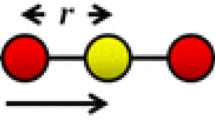Abstract
This study focuses on an extended model of standard cellular automaton (CA), which includes an extra index, comprising a radius that defines a perception area for each cell in addition to the radius defined by the CA rule. Such an extension can be realized by introducing a recursive algorithm called the “Recursive Estimation of Neighbors.” The extended CA rules form a sequence ordered by this index, which includes the CA rule as its first term. This extension aims to construct a model that can be used within the CA framework to study the relation between information processing and pattern formation in collective systems. Even though the extension presented here is merely an extrapolation to a CA having a larger rule neighborhood identical to the perception area, the extra radius can be interpreted as an individual attribute of each cell. The novel perspective to CA provided here makes it possible to build heterogeneous CAs, which contain cells having different extra radii. Several pattern formations in the extension of one-dimensional elementary CAs and two-dimensional Life-like CAs are presented. It is expected that the extended model can be applied to various simulations of complex systems and in other fields.














Similar content being viewed by others
Explore related subjects
Discover the latest articles, news and stories from top researchers in related subjects.References
von Neumann J (1966) The theory of self-reproducing automata. In: Burks AW (ed) Essays on cellular automata. University of Illinois Press, Champaign
Gardner M (1970) Mathematical games. Sci Am 223:102–123
Berlekamp ER, Conway JH, Guy RK (1982) Winning ways for your mathematical plays. Academic, New York
Wolfram S (1983) Statistical mechanics of cellular automata. Rev Mod Phys 55:601–644
Wolfram S (1984) Universality and complexity in cellular automata. Phys D 10:1–35
Wolfram S (1986) Theory and applications of cellular automata. World Scientific, Singapore
Wolfram S (2002) A new kind of science. Wolfram Media, Inc, Champaign
Reynolds CW (1987) Flocks, herds and schools: a distributed behavioral model. ACM Siggraph Comput Graph 21(4):25–34
Banks A, Vincent J, Anyakoha C (2007) A review of particle swarm optimization. Part i: background and development. Nat Comput 6(4):467–484
Li W, Packard N (1990) The structure of the elementary cellular automata rule space. Complex Syst 4:281–297
Kayama Y (2011) Network representation of cellular automata. In: 2011 IEEE symposium on artificial life (IEEE ALIFE 2011) at SSCI 2011, pp 194–202
Langton CG (1990) Computation at the edge of chaos. Phys D 42:12–37
Adamatzky A (ed) (2010) Game of life cellular automata. Springer, London
Eppstein D (2010) Growth and decay in Life-like cellular automata. In: Adamatzky A (ed) Game of life cellular automata. Springer, Berlin, pp 71–98
Callahan P (1995) Patterns, programs, and links for Conway’s game of life. http://www.radicaleye.com/lifepage/. Retrieved at 1 Feb 2011
Flammenkamp A (1998) Achim’s game of life. http://wwwhomes.uni-bielefeld.de/achim/gol.html. Retrieved at 12 Dec 2011
May RM (1976) Simple mathematical models with very complicated dynamics. Nature 261(5560):459–467
Sayama H (2007) Decentralized control and interactive design methods for large-scale heterogeneous self-organizing swarms. Adv Artif Life 15(1):105–114
Sayama H (2009) Swarm chemistry. Artif Life 15(1):105–114
Sayama H (2010) Robust morphogenesis of robotic swarms. Comput Intel Mag IEEE 5(3):43–49
Acknowledgments
The author wishes to thank all the anonymous reviewers for valuable comments and suggestions.
Author information
Authors and Affiliations
Corresponding author
About this article
Cite this article
Kayama, Y. Extension of cellular automata via the introduction of an algorithm for the recursive estimation of neighbors. Artif Life Robotics 21, 338–344 (2016). https://doi.org/10.1007/s10015-016-0287-4
Received:
Accepted:
Published:
Issue Date:
DOI: https://doi.org/10.1007/s10015-016-0287-4




